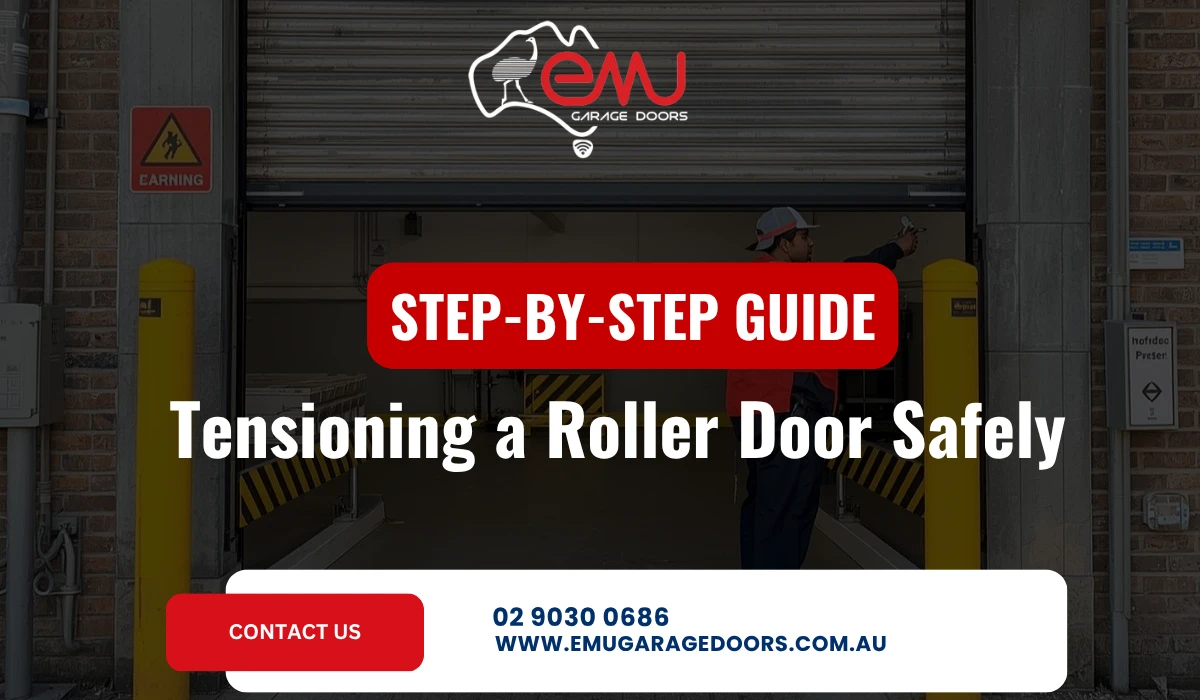If your roller door is running slowly, slamming down, or is simply too difficult to lift, the tension in the door’s spring mechanism likely needs adjustment. Properly tensioning a roller door is essential for its smooth operation and longevity.
This guide will walk you through the process of tensioning a roller door safely and correctly, covering everything from initial checks to final adjustments.
Safety First: Before You Begin
Roller doors use powerful springs that are under significant tension. Working with them can be hazardous if not done correctly.
- Always wear protective gear: Safety glasses and gloves are a must.
- Isolate Power (if applicable): If your door is automated, disconnect the power supply at the wall or fuse box before starting.
- Use the Right Tools: Only use strong, heavy-duty winding bars (or steel rods) designed for this purpose. Never use screwdrivers or pipes, as they can bend or break, causing injury.
- Work Methodically: Take your time and follow these steps precisely.
Tools You Will Need
To safely and correctly retension a roller door, you will need:
- Heavy-Duty Pipe Wrenches (Stilsons) or a specialist Roller Door Tensioning Tool (two are usually required).
- Safety Glasses and Gloves.
- Socket Set or Impact Driver (for U-bolts).
- Tie-down Straps or Rope (for an extra safety measure).
- Ladder (if necessary, for high doors).
Step 1: Initial Assessment and Preparation
Before you learn how to reposition a roller door, you need to understand the existing issue.
- Lower the Door Completely: Ensure the door is fully closed.
- Check for Obstructions: Make sure the garage door tracks are clean and the door can move freely. If the door is binding or sticking due to dirt or damage, adjusting the tension won’t fix it.
- Locate the Winding Wheel: This is the circular component, often with a sprocket for the chain drive, found on one or both ends of the door barrel inside the head box. This wheel connects to the main spring.
- Secure the Barrel: Ask a helper to steady the door barrel or use a clamp to prevent it from spinning before you release the initial tension.
Step 2: Releasing the Existing Tension
To adjust roller door tension, you must first release the old tension.
- Insert the Winding Bars: Locate the winding holes on the winding wheel or the spring anchor plate. Insert one winding bar into a hole.
- Apply Counter-Pressure: Hold the winding bar firmly in place. This bar is holding the current tension.
- Loosen the Set Screws: Using a wrench, carefully loosen the set screws (usually two or three) that lock the winding wheel to the axle/shaft. Do not remove them entirely.
- Slowly Release Tension: While keeping a firm grip on the winding bar, allow the spring to unwind slowly and in a controlled manner. Once the tension is off, you can remove the bar.
Note: For a heavy door, you may need to insert a second winding bar into a hole further down to assist with leverage and safely control the release.
Step 3: Winding the New Tension
The amount of tension needed depends on the size and weight of your garage roller door. The general rule of thumb is to apply 7.5 to 8.5 full turns of the winding wheel.
1. Insert First Winding Bar: Place the first winding bar into a winding hole.
2. Start Winding: Begin rotating the winding wheel in the direction that tightens the spring (usually up or away from the door opening). Keep a count of the turns.
- Example: If your door needs 8 turns, rotate the bar completely around 8 times.
3. Insert Second Winding Bar (Optional but Recommended): Once you have a few turns applied, you may need to insert the second bar to maintain the tension while you reposition the first bar for the next turn.
4. Lock the Tension: Once you’ve reached your target number of turns (e.g., 8 turns):
- Hold the winding bar firmly to maintain the final tension.
- Tighten the set screws securely onto the axle. They must be extremely tight to prevent the spring from slipping.
Step 4: Testing and Fine-Tuning
This is the moment to see how to tension a roller door successfully.
- Lift Test: Release the door from any clamps or restraints. Lift the door about halfway (to chest height).
- Observe the Movement:
- Perfect Tension: The door should stay suspended halfway without falling or pulling itself up. It should require only moderate effort to lift or lower completely.
- Too Much Tension (Overtensioned): The door will try to pull itself up when released halfway. This can strain the tracks and motor (if automated).
- Too Little Tension (Undertensioned): The door will fall heavily or slam down when released. This makes the door hard to lift.
3. Fine-Tuning:
- If Overtensioned: Loosen the set screws slightly, use the winding bar to unwind the garage door spring by a quarter or half turn, then immediately re-tighten the set screws.
- If Undertensioned: Loosen the set screws slightly, use the winding bar to wind the spring tighter by a quarter or half turn, then immediately re-tighten the set screws.
Repeat the lift test until the door is balanced and operates smoothly. Successfully learning how to tension a roller door is a great way to maintain your garage door’s performance. With the right tools and a safety-conscious approach, you can ensure your door operates effortlessly for years to come! If you encounter any resistance, feel unsure, or if the door is excessively large or heavy, it is always best to call a qualified garage door technician.
If you’re unsure about adjusting your garage roller door tension or need professional assistance, contact our expert team today. We provide reliable roller door repair, installation, and maintenance services to ensure your door operates smoothly and safely. Call us now at Emu Garage Doors on 02 9030 0686 for expert help!

